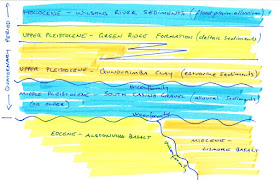In a previous post I discussed some interesting finds in the Dunoon and The Channon area. I discussed how the geological maps of the area are in places incorrect because coal was found in areas that were not expected to contain any. There are two old (Jurassic aged) sedimentary formations present in the area the younger one is called the Kangaroo Creek Sandstone. The Kangaroo Creek Sandstone is mainly comprised of quartz rich sands cemented together and altered by a later period where silica was precipitated on the sand grains creating what is called a saccharoidal texture.
The slightly older formation is called the Walloon Coal Measures and although It was known to occur in the area was not expected to be as widely found. The upper most part of Walloon Coal Measures in this area is a lithic sandstone, a sandstone where the sand grains are actually pieces of rock with different minerals including quartz and feldspar. This sandstone is much duller and weathers to form more silts and clays rather than sandy soils as you’d expect to be found around weathered Kangaroo Creek Sandstone.
 |
| Woody fossil in lithic sandstone |
The lithic sandstone also contains a fair amount of woody fossil fragments. I was surprised how easy it was to find some. The photo to the right shows some of the poor quality fossil wood (technical problems mean that I cant upload the photo - will sort this out soon hopefully). These fossils were located within several metres below the boundary between the Kangaroo Creek Sandstone and the Walloon Coal Measures. It was interesting though, that I could not recognise the type of boundary between these two units even though I could recognise them a short distance apart. That is, I don’t know whether the boundary was gradational or an unconformity.
 |
| A moderately thick layer of weathered coal |
I think what was most interesting for me was the way in which fossil material could be found wherever the Walloon Coal Measures outcrop. This means that they could be just about anywhere in the valleys in the Nimbin area or near Tabulam, on the way to Wooli, Coaldale Valley, all over the place. If you are interested in finding poor quality fossils grab a geological map and look for the boundary between the Kangaroo Creek Sandstone and Walloon Coal Measures.

